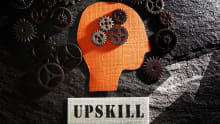Learning often falls behind because it gets stale: Chad Gaydos

Chad Gaydos is the Chief Operating Officer of the Skillsoft Group. He leads the Global field sales organization for Skillsoft, SumTotal, and Vodeclic for the Americas, EMEA and APAC regions and owns the responsibility for leading sales strategy, revenue performance, and customer relationships for more than 6,500 customers worldwide. Prior to Skillsoft, Chad held senior sales positions at SAP, and was the COO for SAP’s Regulated Industries, where he was responsible for sales, operations, customer success and go to market strategy. Chad had been with SAP for 18 years and a member of the Executive Management team since 2007.
Do you think there is a concerning gap between the practical awareness & knowledge of digital transformation, and the planning that L&D professionals need to undertake to prepare their organizations?
Yes, there is a gap between awareness and execution among L&D professionals. Development of human capital on the inside of the organization must keep pace with the constant evolution of technology in our digital economy that is on the outside and creating market pressures. It is incumbent on L&D to prepare their workforces to rise to the digital challenge. That means providing them with high-quality training content that can supplement existing skillsets and competencies with those required to successfully meet the challenges of digital transformation. This may translate into broadly training the workforce in new methodologies like design thinking or agile or it may mean giving every employee some basic training in big data. Preparing the workforce also requires developing new mindsets in the employees, including cultural flexibility, deep collaboration, and adaptability. It also means establishing a strong learning culture and employee growth mindset in the organization as constant upskilling and new knowledge acquisition are going to need to be part of the DNA of every employee in the future. L&D has to play a role in the kind of cultural evolution that is needed to drive digital dexterity and sustain disruption. This entails providing training at a scale that can shift the culture to embrace sustaining elements of disruption like alignment between the business and IT, ingrained innovation (“every day is day one” mentality) and an experimentation culture.
As you mentioned, digital transformation is not just about adopting new technology; it is also about changing the way people perceive things. How is Skillsoft designing its content to prepare organizations/individuals/employees for converging technology and innovation, and change thinking?
Digital transformation is not just about adopting new technology, and that might be the easiest part. It’s about changing an organization’s culture and the mindsets of its workforce. And we know that cultural change can be very hard for companies. The good news is that Skillsoft has a rich catalog of courses in the soft skills areas that can enable an organization to train its workforce at scale in new soft skill competencies and mindsets. Cultural shifts are only possible when there is momentum at scale, so you need to train cost-effectively at scale and e-learning unlocks that. The courses in our business skills collection and digital transformation collection arm the L&D team to design impactful learning programs with rigorous, relevant and engaging content that can drive cultural change. These courses range from establishing a culture of customer centricity to establishing a culture of data literacy. It’s about shifting the mindsets of employees. We design our courses to delight the learner. For our soft skills course content, this means designing scenario-based courses since the scenario is the most engaging and effective soft skills instructional strategy. The human brain learns best through stories and this approach has been scientifically proven to improve recall. Skillsoft is the only provider of content in the area of digital transformation and soft skills business content that heavily leverages scenario as the core instructional approach.
Do you think the lack of content is no longer a problem, but a bigger problem is when content and learning opportunities are mismatched? Is it crucial for L&D departments to consider new approaches to support learner needs?
While there certainly has been geometric growth in learning content available, the quest for relevance and alignment has never been greater. Increasingly, learners are expecting instructional content to be hyper-relevant and targeted to not only their job-role but also the context that they intend to apply the knowledge. This is the fundamental challenge with free or community-generated content. While there are copious amounts of learning content available, without proper curation and alignment, the instructional outcomes and business impact are impossible to achieve. That said, when we think about the design of our intelligent learning platforms, such as Percipio, we place curation and alignment at the central focus, irrespective of whether the content was created by Skillsoft or a third-party. For example, we have curated more than 400 learning channels of content that includes not only video-based courses but thousands of digital books and audiobooks. These channels are based on analytics of millions of learner interactions and consumption patterns and ultimately align to the critical skills and competencies that global organizations look to develop.
L&D has to play a role in the kind of cultural evolution that is needed to drive digital dexterity and sustain disruption
Products fail when they don’t address a crucial customer problem or provide a benefit that genuinely meets the customer’s needs. What does Skillsoft do to continuously innovate so as to enable performance support whenever and wherever learners need it?
Learning often falls behind because it gets stale. There’s a lot of energy within a company when a learning initiative is launched but over time, the content curation isn’t refreshed. Naturally, organizations want to provide a constant stream of fresh and engaging learning content, but they often lack the time and resources to meet this goal. For the most dominant and relevant topics, Percipio provides 500 pre-curated channels maintained actively by Skillsoft experts. Continuous curation is a key business pain point that Percipio addresses. Furthermore, it provides tools and services for company-specific custom curation and recommendations for curation. It’s also important to foster a culture of learning throughout the work day and not just during training sessions. Skillsoft’s ELSA solution is our innovative approach to provide users single-click access to learning content from within a document they’re working on, thus providing learning within the flow of work tasks. Percipio’s mobile offering is state of the art and can offer videos or audiobooks whenever and wherever learners need it. On Percipio’s innovation roadmap, we have mobile learning reinforcement which continuously reinforces learning for higher performance and retention.
Digital transformation is not just about adopting new technology; it is about changing an organization’s culture and the mindsets of its workforce
When we talk about technology, virtual reality is going to be the next big thing in learning. What are your thoughts on that?
Both virtual and augmented reality are and will continue to have a big impact on how people learn and experience learning content. Virtual reality and augmented reality are already in use today in industrial and military training. We expect such things to become mainstream as the cost of production and distribution goes down. Percipio is well prepared as a platform to leverage this new type of content as its integrations with popular devices like Oculus to render this type of user experience have already been developed and are being tested in our labs where we develop new technology and product innovations. It also supports xAPI which we’ll be launching this coming June. Percipio support of xAPI enables users to track and capture a learner’s engagement with learning content at a much more granular level compared to course completion or video viewing duration metrics. We can imagine that one-day xAPI in Percipio may be used to store biometrics as part of course transcripts (e.g. learner reaction when put in a virtual adverse situation). We are very excited about these cutting-edge technology developments currently underway in our labs.
When it comes to the APAC region, how different or adaptive do you think APAC organizations are when it comes to learning tech adoption?
First, it’s important to understand the cultural diversity in each country within the APAC region. It’s also important to immerse in the unique culture of each organization to ensure a clear understanding of the outcomes they want to achieve. A strategic partner approach is the best way to gain insights into the learning challenges organizations face. Once this foundation is established, you can begin building the case for the tech and solution adoption needed to address their learning challenges. This approach gives organizations the confidence to fully control their own learning experience and ensure they achieve their desired outcomes and goals. SumTotal and Skillsoft are strongly positioned to address the full range of an organization’s learning needs in APAC and across the Globe by offering a truly integrated experience with our core HR, Learn, Talent and workforce management offerings. Combined with our Percipio intelligent learning platform and the world’s largest library of learning assets, we can design solutions to meet any organizations learning needs.
India is one of the fastest e-learning markets in the word. What are Skillsoft’s plans for future in India?
India is a very important part of our overall strategy. Over the past few years, India has been one of our fastest growing regions and we are absolutely committed to helping Indian organizations and individuals build future skills. Indian companies are increasingly becoming globally competitive and are focusing on digital transformation, leadership development, and talent management to achieve success. Moreover, India’s young and vibrant workforce is poised to acquire future skills that will make them competitive globally. Skillsoft brings a unique combination of technology+content+services to help individuals acquire future skills and companies to achieve their strategic imperatives. While we continue to expand our presence in the enterprise and SMB segments in India, we are also foraying into government, public, and higher education sectors. We are keen on partnering with the Indian government on the national and state levels in their Digital Transformation initiatives. We believe that as the world’s leading provider of Digital Learning, Skillsoft can play a crucial role in supporting Digital India and Skill India initiatives.





